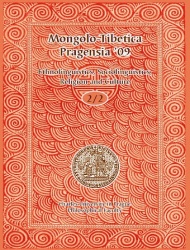MONGOLO-TIBETICA PRAGENSIA '09, Ethnolinguistics, Sociolinguistics, Religion and Culture. Vol. 2, No. 2. 2009
Special Commemorative Issue in Honour of Assoc. Prof. J. Lubsangdorji on his 70th birthday

Editors-in-chief : J. Vacek and A. Oberfalzerová
Editorial Board:
Daniel Berounský (Charles University in Prague)
Agata Bareja-Starzyńska (University of Warsaw, Poland)
Katia Buffetrille (École pratique des Hautes-Études, Paris, France)
J. Lubsangdorji (Charles University Prague)
Marie-Dominique Even (Centre National des Recherches Scientifiques, Paris, France)
Tsevel Shagdarsurung (National University of Mongolia, Ulaanbaatar, Mongolia)
Domiin Tömörtogoo (National University of Mongolia, Ulaanbaatar, Mongolia)
English correction: Dr. Mark Corner, formerly lecturer at Charles University, presently HUB University, Brussels
Institute of South and Central Asian Studies, Seminar of Mongolian Studies
Faculty of Philosophy, Charles University in Prague
Celetná 20, 116 42 Praha 1, Czech Republic
http://mongolistika.ff.cuni.cz/
Published by Triton
First edition, Praha (Prague) 2008
ISSN 1803-5647
Registration number of MK ČR E 18436
The publication of this journal was financially supported by the Ministry of Education of the Czech Republic as a part of the Research Project No. MSM0021620825 “Language as human activity, as its product and factor”, a project of the Faculty of Philosophy, Charles University in Prague.
For acquisition please contact
Contents:
Agata Bareja-Starzyńska (University of Warsaw, Poland)The ‘Spiritual Sons’ of the first Mongolian Jetsundampa Zanabazar (1635–1723)
The paper investigates the list of close disciples of the first Mongolian Jetsundampa Öndör Gegeen Zanabazar (1635–1723) presented in his three biographies. Zanabazar played a very important role in spreading Buddhism among the Khalkha Mongols in the seventeenth and eighteenth centuries and his main pupils were also influential incarnations and religious activists. The paper attempts to bring out some information about these figures in order to learn more about Mongolia’s Buddhist and intellectual past.
Daniel Berounský (Charles University in Prague): “Soul of enemy” and warrior deities (dgra bla): Two Tibetan myths on primordial battle
The paper brings translations of two mythical narrations on warrior deities (dgra lha/ sgra bla/ dgra bla), one from the Bonpo text and the second from the “Old” (Rnying ma) tradition of Tibetan Buddhism. Both are partly in contrast and reveal something of the ways of incorporation of the older religious ideas into the frame of Buddhism. Some general background of the warrior deities is discussed in the introductory parts of the paper. It is pointed out that the ritual of “imprisoning the soul of enemies” (dgra bla brub), described also in the translated Bonpo text, might be related to the probably oldest written form dgra bla (“enemy-soul”) used for the warrior deities in Dunhuang texts.
Zuzana Vokurková (Charles University in Prague): The lexical and grammatical expression of epistemic meanings in spoken Tibetan
The aim of the present paper is to show that in spoken Tibetan, epistemic modalities are not expressed by modal verbs as is the case with many languages of the world, especially European languages, but by other lexical and grammatical means. The lexical means include, in particular, epistemic adverbs. However, the main means in the spoken language is morpho-syntactic. It is a system of epistemic verbal endings. This system will be discussed in detail in this paper.
Jaroslav Vacek (Charles University in Prague): Dravidian and Altaic – two layers in Dravidian due to ancient high contact?
This paper draws general conclusions about the implications of the parallels found between Dravidian and Altaic. In the margin it also offers several important parallels concerning the ‘chieftain’ or ‘king’ and a few words referring to the related ‘instruments of power’ (‘chariot’, ‘axe’, ‘bow’, ‘bow-string’), possibly also ‘hunting’ (including the ‘hook’). The parallels established so far (see the references below) are too numerous to be mere coincidence. But at the same time there are important gaps (no parallel numerals or personal pronouns) on the one hand, and on the other hand we encounter a great variation of forms, irregularities in the phonetic correspondences and numerous doublets in all the languages concerned. These ‘symptoms’ are a clear indication that we have to do not with a language family but with an ancient contact between languages with all that this entails. It was obviously a ‘high contact’. The question of when and where this contact took place remains open and though there are some hypothetical implications pointing to the 1st half of the 1st Millennium B.C. on (South) Indian soil, this hypothesis will have to be checked against many more linguistic, archaeological and anthropological data.

